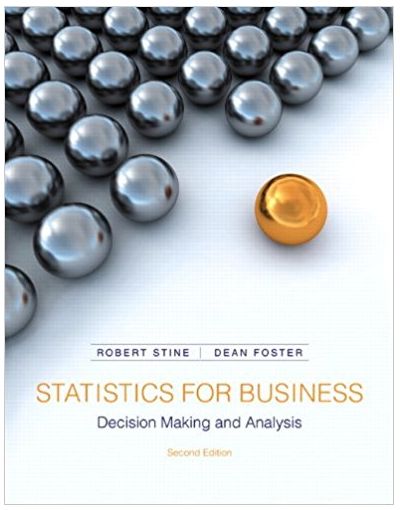Collinearity among the predictors is common in many applications, particularly those that track the growth of a
Question:
For this exercise, you€™re the manager who allocates advertising dollars. You have a fixed total budget for advertising, and you have to decide how to spend it. We€™ve simplified things so that you have two choices: print ads or television.
The past two years have been a time of growth for your company, as you can see from the timeplot of weekly sales during this period. The data are in thousands of dollars, so you can see from the plot that weekly sales have grown from about $2.5 million up to around $4.5 million.
-1.png)
Other things have grown as well, namely your expenditures for TV and print advertising. This timeplot shows the two of them (TV in green, and print ads in red), over the same 104 weeks.
-2.png)
With everything getting larger over time, all three variables are highly correlated.
Motivation
(a) How are you going to decide how to allocate your budget between these two types of promotion?
Method
(b) Explain how you can use multiple regression to help decide how to allocate the advertising budget between print ads and television ads.
(c) Why would it not be enough to work with several, more easily understood simple regression models, such as sales on spending for television ads or sales on spending on print ads?
(d) Look at the scatterplot matrix of Sales, the two explanatory variables (TV Adv and Print Adv), and a time trend (Week). Do the relationships between the variables seem straight enough to ft a multiple regression?
(e) Do you anticipate that collinearity will affect the estimates and standard errors in the multiple regression? Use the correlation matrix of these variables to help construct your answer.
Mechanics
Fit the multiple regression of Sales on TV Adv and Print Adv.
(f) Does the model satisfy the assumptions for the use of the MRM?
(g) Assuming that the model satisfies the conditions for the MRM,
i. Does the model as a whole explain statistically significant variation in Sales?
ii. Does each individual explanatory variable improve the ft of the model, beyond the variation explained by the other alone?
(h) Do the results from the multiple regression suggest a method for allocating your budget?
Assume that your budget for the next week is $360,000.
(i) Does the ft of this model promise an accurate prediction of sales in the next week, accurate enough for you to think that you have the right allocation?
Message
(j) Everyone at the budget meeting knows the information in the plots shown in the introduction to this exercise: Sales and both types of advertising are up. Make a recommendation with enough justification to satisfy their concerns.
(k) Identify any important concerns or limitations that you feel should be understood to appreciate your recommendation.
Step by Step Answer:

Statistics For Business Decision Making And Analysis
ISBN: 9780321890269
2nd Edition
Authors: Robert Stine, Dean Foster





